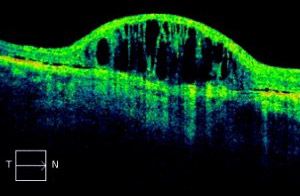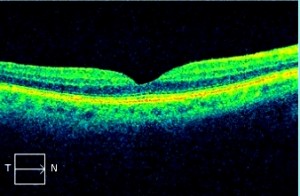The macula is the name given to the area at the very centre of the retina. It provides our detailed central vision and most colour vision. It is responsible for our ability to read, recognise faces, drive, see colours clearly and any other activity requiring fine vision. The rest of the retina is called the peripheral retina. It is used to see general shapes and gives us “get-about” vision, also known as side or peripheral vision.
Macular Degeneration is the name given to a group of degenerative retinal eye diseases that cause progressive loss of central vision, leaving the peripheral or side vision intact.
 OCT Scan – Macula degeneration
OCT Scan – Macula degeneration OCT Scan – Normal Retina
OCT Scan – Normal RetinaIt is the leading cause of blindness and severe vision loss in Australia.
MD most frequently affects people over the age of 50. It is commonly referred to as Age-related Macular Degeneration or AMD. However, inherited forms of the disease can also affect young people. AMD is progressive and painless. It never leads to total or black blindness.
Family history, age, smoking, and diet and lifestyle factors. Smokers are three times more likely to develop MD.
There are currently no treatments available to reverse the effects of dry AMD, however vitamins, minerals and antioxidants may slow its progression.
An excessive growth of blood vessels in Wet MD causes bleeding, leaking and scarring which results in severe loss of vision. The blood vessels are prompted to grow by a protein called Vascular Endothelial Growth Factor (VEGF). In the case of anti-VEGF drugs, an antibody, called an anti-VEGF, is injected into the eye cavity where it spreads to the retina and blocks the growth of blood vessels.
Lucentis and Avastin are anti-VEGF drugs which has been shown to be highly effective. The aim of treatment is to prevent further loss of vision.
Laser Photocoagulation treatment consists of a concentrated light beam of high energy thermal light which is directed on to the retina to destroy and seal the leaky blood vessels.